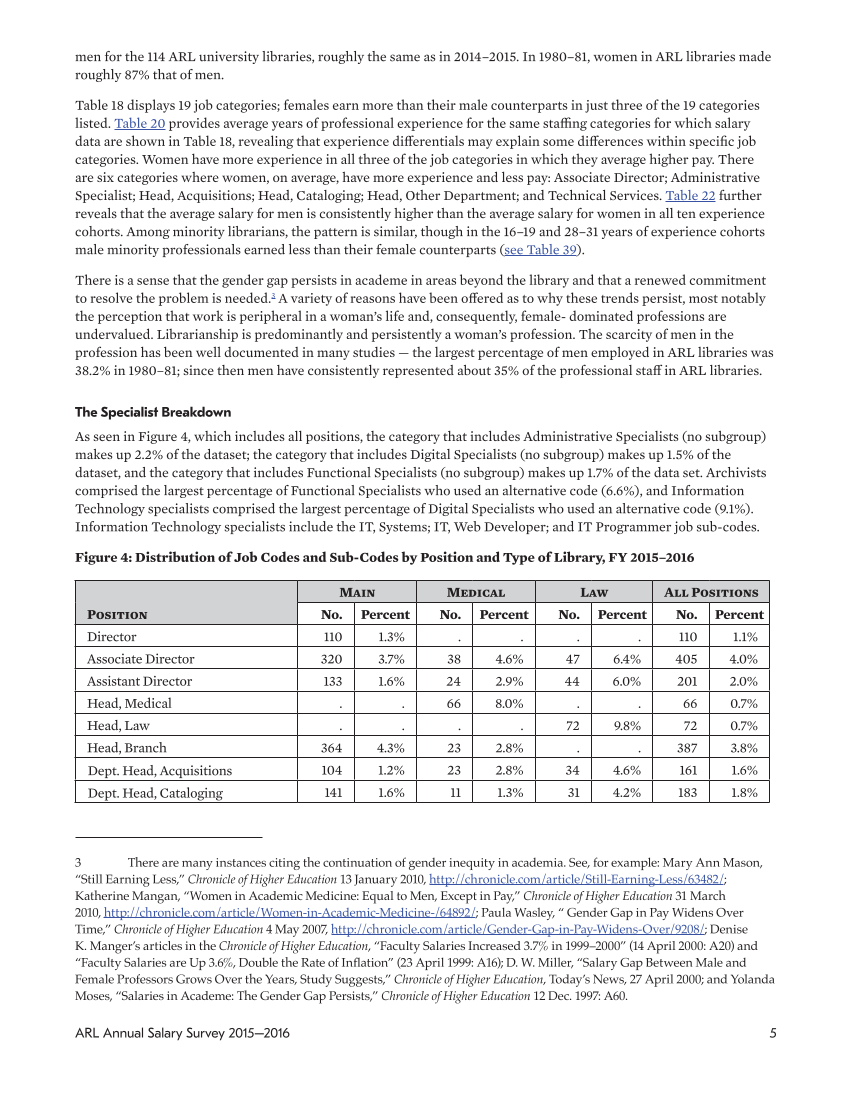5 ARL Annual Salary Survey 2015–2016 men for the 114 ARL university libraries, roughly the same as in 2014–2015. In 1980–81, women in ARL libraries made roughly 87% that of men. Table 18 displays 19 job categories females earn more than their male counterparts in just three of the 19 categories listed. Table 20 provides average years of professional experience for the same staffing categories for which salary data are shown in Table 18, revealing that experience differentials may explain some differences within specific job categories. Women have more experience in all three of the job categories in which they average higher pay. There are six categories where women, on average, have more experience and less pay: Associate Director Administrative Specialist Head, Acquisitions Head, Cataloging Head, Other Department and Technical Services. Table 22 further reveals that the average salary for men is consistently higher than the average salary for women in all ten experience cohorts. Among minority librarians, the pattern is similar, though in the 16–19 and 28–31 years of experience cohorts male minority professionals earned less than their female counterparts (see Table 39). There is a sense that the gender gap persists in academe in areas beyond the library and that a renewed commitment to resolve the problem is needed.3 A variety of reasons have been offered as to why these trends persist, most notably the perception that work is peripheral in a woman’s life and, consequently, female- dominated professions are undervalued. Librarianship is predominantly and persistently a woman’s profession. The scarcity of men in the profession has been well documented in many studies — the largest percentage of men employed in ARL libraries was 38.2% in 1980–81 since then men have consistently represented about 35% of the professional staff in ARL libraries. The Specialist Breakdown As seen in Figure 4, which includes all positions, the category that includes Administrative Specialists (no subgroup) makes up 2.2% of the dataset the category that includes Digital Specialists (no subgroup) makes up 1.5% of the dataset, and the category that includes Functional Specialists (no subgroup) makes up 1.7% of the data set. Archivists comprised the largest percentage of Functional Specialists who used an alternative code (6.6%), and Information Technology specialists comprised the largest percentage of Digital Specialists who used an alternative code (9.1%). Information Technology specialists include the IT, Systems IT, Web Developer and IT Programmer job sub-codes. Figure 4: Distribution of Job Codes and Sub-Codes by Position and Type of Library, FY 2015–2016 Position Main Medical Law All Positions No. Percent No. Percent No. Percent No. Percent Director 110 1.3% ....110 1.1% Associate Director 320 3.7% 38 4.6% 47 6.4% 405 4.0% Assistant Director 133 1.6% 24 2.9% 44 6.0% 201 2.0% Head, Medical ..66 8.0% ..66 0.7% Head, Law ....72 9.8% 72 0.7% Head, Branch 364 4.3% 23 2.8% ..387 3.8% Dept. Head, Acquisitions 104 1.2% 23 2.8% 34 4.6% 161 1.6% Dept. Head, Cataloging 141 1.6% 11 1.3% 31 4.2% 183 1.8% 3 There are many instances citing the continuation of gender inequity in academia. See, for example: Mary Ann Mason, “Still Earning Less,” Chronicle of Higher Education 13 January 2010, http://chronicle.com/article/Still-Earning-Less/63482/ Katherine Mangan, “Women in Academic Medicine: Equal to Men, Except in Pay,” Chronicle of Higher Education 31 March 2010, http://chronicle.com/article/Women-in-Academic-Medicine-/64892/ Paula Wasley, “ Gender Gap in Pay Widens Over Time,” Chronicle of Higher Education 4 May 2007, http://chronicle.com/article/Gender-Gap-in-Pay-Widens-Over/9208/ Denise K. Manger’s articles in the Chronicle of Higher Education, “Faculty Salaries Increased 3.7% in 1999–2000” (14 April 2000: A20) and “Faculty Salaries are Up 3.6%, Double the Rate of Inflation” (23 April 1999: A16) D. W. Miller, “Salary Gap Between Male and Female Professors Grows Over the Years, Study Suggests,” Chronicle of Higher Education, Today’s News, 27 April 2000 and Yolanda Moses, “Salaries in Academe: The Gender Gap Persists,” Chronicle of Higher Education 12 Dec. 1997: A60.






































































































































































